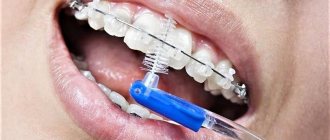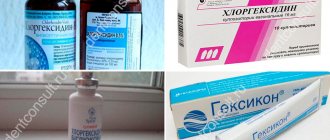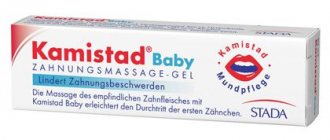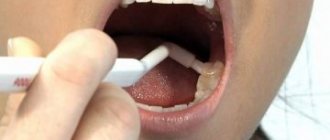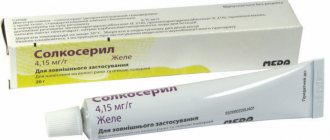What kind of remedy is this?
If ultrasound or mechanical teeth cleaning are contraindicated, a chemical method is used . Modern means of chemical treatment include Scaling gel. It is an alternative method if it is not possible to use medical instruments to remove hard deposits from teeth.
The drug is used to clean teeth of unnecessary stones in adults and to dissolve greenish plaque in children.
The effect of this dental gel is based on the fact that it is able to soften the hard tissue of dental plaque , which subsequently dissolves. The tooth enamel remains intact.
The drug consists of special particles that, when applied to teeth, stain damaged tissue. This makes diagnosis easier.
The dental product, in addition to all of the above, has good whitening properties. This effect can persist in patients with constant oral hygiene for about three months. The drug is very easy to use and has a very affordable price.
The drug contains the following components:
- silica;
- distilled water;
- iodine-containing substance “potassium iodide”;
- hydrochloric acid;
- polyhydric alcohols;
- special thickener;
Ultrasound is a modern way to combat tartar
Preventive cleaning of teeth from stone with ultrasound has long been a mandatory procedure in civilized countries. In our country, there is no such practice yet, so patients are more negligent about their health and most often turn to the dentist when there are obvious health problems.
The procedure for cleaning teeth with an ultrasonic scaler in dentistry is carried out by a hygienist or periodontist. The specialist assesses the condition of the teeth and gums, excludes contraindications, selects the necessary attachment for the device and begins treatment.
In case of increased sensitivity of the enamel and deep cleaning of the subgingival area, the doctor may use local anesthesia - this will make the patient more comfortable during the procedure.
Under the influence of high-frequency ultrasonic vibrations, any dental deposits are destroyed, and pathogenic bacteria are destroyed from the surface of the teeth and from periodontal pockets. Ultrasonic cleaning lasts about an hour and ends with an enamel polishing procedure. You will not only see, but also feel the result: your teeth will become clean, smooth - and no hint of dark plaque.
In children, teeth cleaning from tartar and plaque with ultrasound is carried out after changing the primary bite to a permanent one and exclusively for medical reasons.
Despite the fact that ultrasonic cleaning is a safe procedure, it has a number of contraindications:
- general somatic diseases in acute form
- colds and ARVI
- infectious diseases
Ultrasound should be used with caution in patients with an artificial cardiac pacemaker.
Ultrasonic tartar removal is the most effective and fastest way to make your smile attractive again. For preventive purposes, this procedure is recommended to be carried out every six months, and for those who wear braces, even more often - once every 3 months.
Indications for use
The properties that this gel has determine its use for the purpose of cleansing hard plaque on teeth, even in the complex therapy of periodontal disease in adults.
Teeth affected by periodontal disease are most often mobile, so it is quite difficult to remove hard deposits from them. There is a risk of damage to the teeth themselves.
Products such as abrasive paste are not suitable, which is why they resort to using gel. It removes stones painlessly.
The coloring elements included in the gel can be used to find damage that is difficult to identify using other methods. They change the color of both healthy and damaged tissue for some time.
“Scaling” can also be used to remove stones in children. It is absolutely safe.
How much does tartar removal cost?
The price of the procedure for removing tartar with ultrasound or laser is usually included in the cost of the complex, called professional hygiene. Some clinics set a total price for hygienic cleaning of the entire oral cavity, and some set a general price for the treatment of one tooth. So, in Moscow, the price for cleaning one tooth, including removing tartar from it, ranges from 50 to 500 rubles, that is, the cost of the entire procedure, depending on the number of teeth and the category of the clinic, will vary from 1,400 to 16,000 rubles and more .
Should I remove tartar? For people who care about the health of their teeth, the answer to this question will be clear. Tartar should be removed in the same way as brushing your teeth and removing thick plaque on the tongue. And, of course, we must not forget about professional oral hygiene. Remember that by coming to a specialist on time, you are laying a healthy foundation for your health without leaving a single stone on your teeth.
Contraindications
Contraindications include intolerance to any individual component included in the dental gel. For example, an allergic reaction to potassium iodides. And also contraindications common to all cleaning methods:
- infectious processes occurring in the gums;
- acute respiratory viral infections;
- special sensitivity of tooth enamel or damage to it;
- pregnancy in the last months.
All of the listed contraindications can be eliminated or adjusted.
Prevention
Preventing the appearance of tartar involves careful oral hygiene and timely consultation with a specialist.
It is important to choose the right toothbrush. Its fibers should be neither too soft nor too hard. The toothpaste should also be of high quality. There are special toothpastes that contain substances that destroy deposits on teeth. After it, you can use auxiliary means - oral irrigators, rinses, dental floss.
It is worth paying attention to bad habits and diet. More fruits and nuts, clean still water and less sweets and starchy foods, quitting smoking are beneficial changes not only for the oral cavity, but for the whole body
Mode of application
- At the initial stage of the procedure for cleaning tartar, it is necessary to prevent the substance from getting on the gums.
- Then one of the syringes with the contents of the gel is taken from the package and the cap is removed from the instrument. A metal cannula, called an applicator, is placed on the syringe.
- Using applied force, the gel is squeezed onto the affected area with hard dental plaque that requires treatment. The product should be left to act on tartar for 35-40 seconds.
- Then the gel is removed from the surface to be treated with special tools and thoroughly washed with water.
- After the cleaning process, you need to remove the cannula from the syringe and close the instrument with a special cap.
In particularly difficult cases, it is recommended to perform dental procedures several times to achieve the desired effect. At the same time, do not forget to always protect the gums from getting the gel on it.
It must be remembered that Scaling gel is used exclusively in medical clinics. Do not use the drug at home.
You should know that after the plaque cleaning procedure, it is important to carefully follow strict oral care recommendations . They should include daily (morning and evening) brushing of teeth, gums and tongue, as one of the sources of decomposition of various microorganisms.
There is no need to be overzealous with eating foods that are colored or contain a lot of carbohydrates. This can leave pigmentation on the enamel and promote bacterial deposits. If, after scaling, bad breath appears again after several months, you must repeat this stone removal procedure again.
Removing tartar: conclusions
- Without the intervention of a dentist, small hard dental deposits, as well as not too pronounced smoker’s pigment deposits, can only be dealt with by either professional dental products such as “Detartrine-Z” or toothpaste with an RDA 200 index. These products should be used with an Oral electric toothbrush -bi (in low speed mode), preferably no more than once every 10 days.
The effectiveness of such a complex will depend on your level of hygiene. After all, if you still don’t brush your teeth after every meal or don’t use dental floss, your mouth will continue to experience intensive formation of tartar and pigmented plaque. For information on how to properly brush your teeth, read the article: → “Prevention of dental and gum diseases” - Traditional “grandmother’s” remedies are completely powerless against tartar. Due to its very high strength, tartar cannot be dissolved by any available means without causing irreparable damage to the teeth and oral mucosa. Toothpastes often use pyrophosphates, bromelain, and polydone to loosen plaque. These components are safe for teeth, but they are effective precisely for preventing the formation, and not for dissolving already formed tartar.
Remember that there are many recipes on the Internet that are completely ineffective and even those that can cause irreparable damage to dental health. Unfortunately, most of these recipes are devoid of any common sense and are written by people who have nothing to do with medicine. We hope that our article was useful to you!
Sources:
1. Dental education of the author of the article, 2. Based on personal experience as a periodontist, 3. https://oralb.com/, 4. https://www.presi-dent.ru/, 5. https://www.lacalut.ru/.
Methods for removing deposits from enamel
There are several types of procedures to help get rid of tartar. They differ in the method of influencing education:
1) Physical
The method involves mechanical destruction of the layer, which until recently was carried out using dental instruments with a pointed tip. The Air flow technique is now widely used, when a stream of air is supplied under pressure, delivering sodium bicarbonate to the contaminated area. The soda crushes the plaque, and the subsequent stream of water washes away the broken pieces.
2) Chemical
Involves the use of aggressive chemical compounds to dissolve salt formation. The teeth are treated using a cotton pad, which is moistened in the solution. Softened stone is much easier to remove, and the gums and enamel are subjected to minimal pressure.
3) Exposure to ultrasound
Separation of fossilized plaque using ultrasonic waves allows you to preserve the integrity of the enamel and not damage the gums. This method cannot be used for patients who have a pacemaker installed, so as not to provoke a malfunction of the device.
4) Laser radiation
This method is the most expensive, but very effective in the fight against tartar. In this case, a laser beam is used to crush the fossil into small pieces.
Removal procedure
Typically, the process of getting rid of plaque and tartar includes several stages:
- determining the degree of tooth sensitivity and using local anesthetics if necessary;
- removal of deposits using the chosen method;
- cleansing tooth enamel from residual formation elements;
- polishing the tooth using a special brush and hygienic paste;
- coating the enamel with varnish to strengthen it.
Existing contraindications to the procedure
Ultrasonic cleaning is safe and harmless to teeth. But the procedure also has certain contraindications. You cannot remove stones with ultrasound:
- Persons suffering from cardiac arrhythmia.
- For asthmatics and those suffering from chronic bronchitis.
- People with implants and other types of dentures.
- Pregnant women in the first trimester.
- Suffering from tooth hypersensitivity.
Other patients can safely sign up for this procedure.
